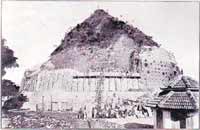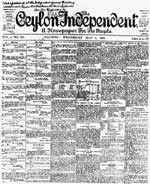Patriot who resurrected Anuradhapura
The patriot responsible for the restoration of Anuradhapura, Sri Lanka's first capital, Bramachari Walisinghe Harischandra was born on July 9, 1876. Leading a non-violent struggle for the protection of the rights of the Buddhists and Buddhist antiquities in Anuradhapura, he launched his campaign to save the sacred city in November1898 as a young man of 22. While creating awareness throughout the country, he founded the 'Ruwanveli Chaityawardhana Society' in 1902. 'The Sacred City of Anuradhapura' - a booklet written by him in 1904 traced the history of the great city with a short account on 'The best way to see the ruins' prompting the pilgrims to visit the city. He took the initiative in building a new town by demarcating the sacred area after the Sinhalese kings. Born at Maha Hunupitiya, Negombo, his parents named him Edward de Silva. He was five when his parents handed him over to a scholarly monk, Ven. Dhammaratana Tissa Thera and he read his first letters at Sugatharama temple. He was later admitted to St Mary's High School, Negombo from where he shifted to Wesley College and studied to become a lawyer. He later gave up that idea and decided to observe the discipline of celibacy dedicating his life to the cause of Buddhism. He changed his name to E.D.S Walisinghe and served as a teacher at the 'daham' school Ananda College. He played an active role in the temperance movement and closely followed the footsteps of Anagarika Dharmapala. He died on September 13, 1913 at the young age of 37 by which time had conducted 1363 public discourses throughout the country and written several books.
Another English newspaper
Mid-1880s was the era of English newspapers. Between 1832 and 1898 nine new English newspapers appeared. 'Ceylon Independent' commenced publication on July 4, 1888. An eight-page morning sheet, it made its mark as the cheapest newspaper of the day. Known as the first 'penny' newspaper, it was sold for five cents when an evening newspaper was being sold for 15 cents. The low price attracted a lot of readers and 'Ceylon Independent' soon became popular. Realising this, the 'Observer' which was started in 1834 and 'the 'Times' (started as 'Ceylon Times' in 1846 and the name was changed to 'Times of Ceylon' in 1883) dropped the price to 10 cents. With 3,270 copies, the paper claimed to have the largest circulation in Ceylon. 'Ceylon Independent' was started by Hector Van Cuylenburg and William Maitland. It made a name for its outspokenness and based its main claim "to popular support in the fearless ventilation of public questions and bold exposure of public evils". It was supportive of and was sympathetic towards strikers giving space to present their point of view whenever there was a strike against the British employers. It took the side of the masses in public issues.
A journalist of repute Charles Ambrose Lorenz (1829- 71), a radical lawyer and journalist was born on July 8, 1829. He served as the nominated Burgher representative in the Legislative Council and agitated for an increase in the number of unofficial members to outnumber official members. In 1860, he was among a group of lawyers who bought the 'Examiner' newspaper and published as the 'Ceylon Examiner'. He edited the paper for ten years and is credited with having coined the term 'Ceylonese'.
|
|||||||||||
Copyright © 2006 Wijeya Newspapers
Ltd. All rights reserved. |

